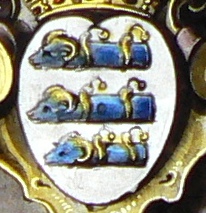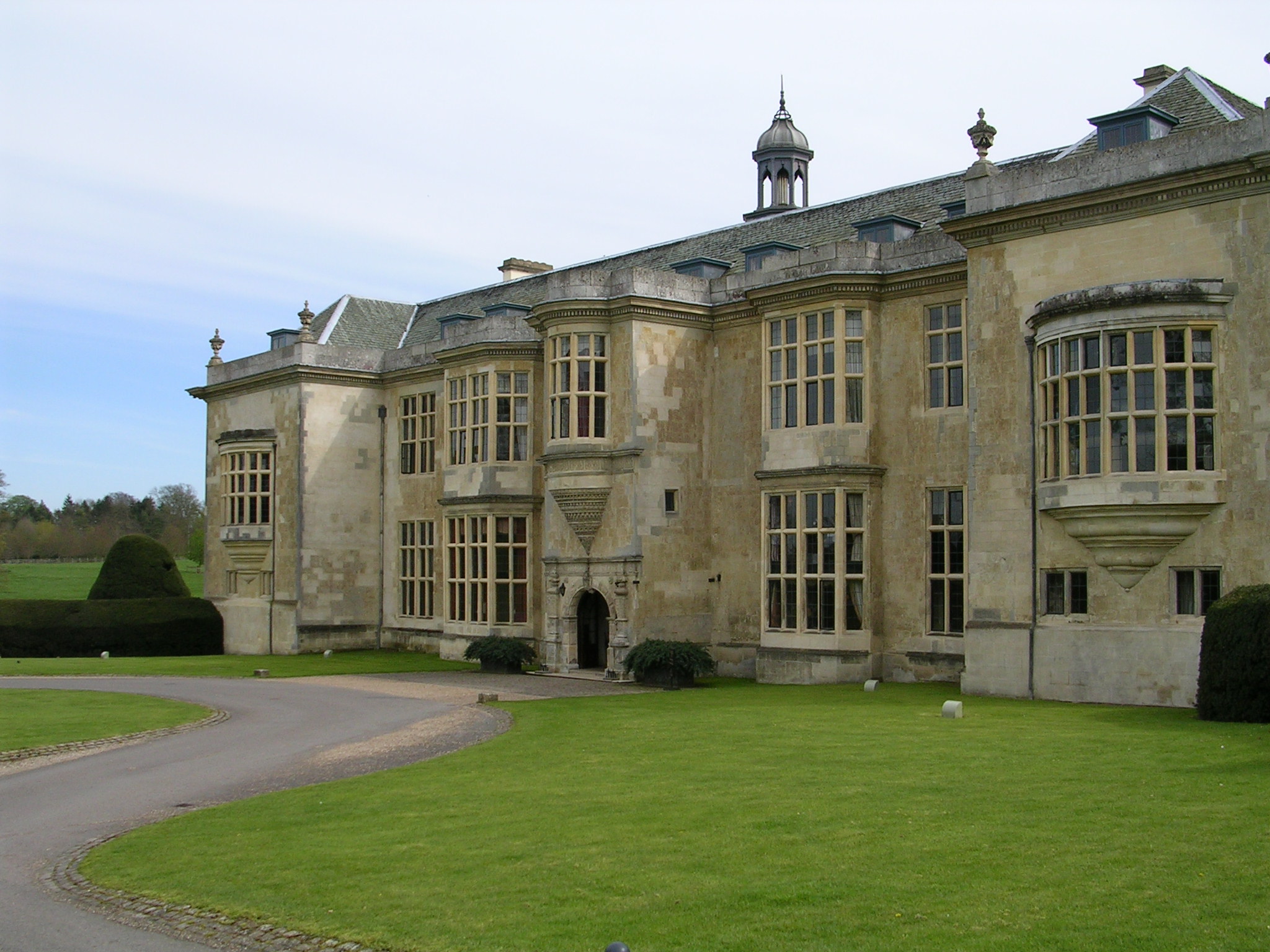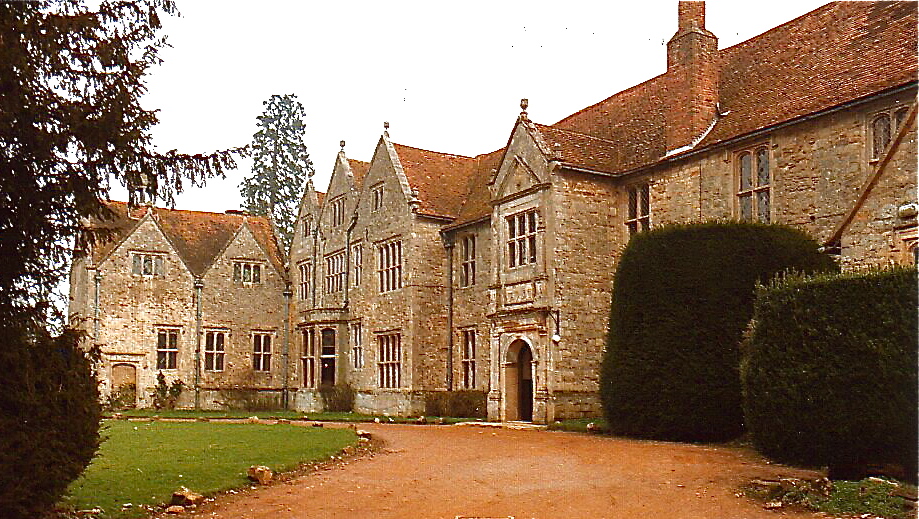|
James Bertie, 1st Earl Of Abingdon
James Bertie, 1st Earl of Abingdon (16 June 1653 – 22 May 1699), styled Hon. James Bertie until 1657 and known as the 5th Baron Norreys from 1657 until 1682, was an English nobleman. Early life and relations Bertie was the eldest son of Montagu Bertie, 2nd Earl of Lindsey, by his second wife, Bridget Bertie (née Wray), 4th Baroness Norreys. His father, who had five sons by his previous marriage, was a royalist of impeccable credentials, and the head of an influential Lincolnshire family. While James' position as a sixth son might have limited his prospects, he was his mother's eldest son, and upon her death in c.1657, he became the 5th Baron Norreys of Rycote. Together with the peerage, he inherited from his mother considerable estates, including the manors of Rycote, Albury, Wendlebury, Chesterton, Dorchester, Thame, Beckley and Horton in Oxfordshire, and Wytham, Cumnor and Frilsham, all then in Berkshire. These extensive estates would provide him with a base of political ... [...More Info...] [...Related Items...] OR: [Wikipedia] [Google] [Baidu] |
The Right Honourable
''The Right Honourable'' ( abbreviation: ''Rt Hon.'' or variations) is an honorific style traditionally applied to certain persons and collective bodies in the United Kingdom, the former British Empire and the Commonwealth of Nations. The term is predominantly used today as a style associated with the holding of certain senior public offices in the United Kingdom, Canada, New Zealand, and to a lesser extent, Australia. ''Right'' in this context is an adverb meaning 'very' or 'fully'. Grammatically, ''The Right Honourable'' is an adjectival phrase which gives information about a person. As such, it is not considered correct to apply it in direct address, nor to use it on its own as a title in place of a name; but rather it is used in the third person along with a name or noun to be modified. ''Right'' may be abbreviated to ''Rt'', and ''Honourable'' to ''Hon.'', or both. ''The'' is sometimes dropped in written abbreviated form, but is always pronounced. Countries with co ... [...More Info...] [...Related Items...] OR: [Wikipedia] [Google] [Baidu] |
Chesterton, Oxfordshire
Chesterton is a village and civil parish on Gagle Brook, a tributary of the Langford Brook in north Oxfordshire. The village is about southwest of the market town of Bicester. The village has sometimes been called Great Chesterton to distinguish it from the hamlet of Little Chesterton, about to the south in the same parish. The 2011 Census recorded the parish population as 850. Archaeology About west of the village, by the crossroads of Akeman Street and the former Oxford – Brackley main road (now the B430) is a prehistoric tumulus. Chesterton village is on the course of Akeman Street, the Roman road between Watling Street and Cirencester, about northwest of Alchester Roman Town. The road forms part of the southwest boundary of the parish. When the M40 motorway was extended from Wheatley to Birmingham in 1988–91, the motorway cut through Akeman Street about west of the village. The Roman layers of the road were exposed about below Akeman Street's modern surface. The ... [...More Info...] [...Related Items...] OR: [Wikipedia] [Google] [Baidu] |
Marden, Wiltshire
Marden is a small village and civil parish southeast of Devizes in the county of Wiltshire, south west England. The parish is in the Vale of Pewsey which carries the upper section of the Salisbury Avon; to the south the parish extends into Salisbury Plain. History A settlement of 29 households and one mill was recorded at ''Meresdene'' in Domesday Book of 1086. The Victoria County History traces ownership of the mill – on the Avon in the north of the parish – from the 15th century until 1970, when it was still grinding corn, albeit by electrical power; the property was sold for residential use in 1975. The three-storey mill of 1842 and adjoining two-storey house, both in red brick, were recorded as Grade II listed in 1988. Holders of Marden manor included Gilbert Basset and his brothers Fulk (bishop of London) and Philip, all in the 13th century; and Hugh le Despenser the elder from 1298 to 1326. After Despenser's execution, the manor was granted to Queen Isabella and th ... [...More Info...] [...Related Items...] OR: [Wikipedia] [Google] [Baidu] |
West Lavington, Wiltshire
West Lavington is a village and civil parish in Wiltshire, England, on the north edge of Salisbury Plain, on the A360 road between Devizes and Salisbury, about south of Devizes. The parish includes the hamlet of Littleton Panell. The parish was formerly known as Bishops' Lavington, the land having been granted to Roger, Bishop of Salisbury in 1136, and remaining in the hands of the bishopric throughout the Middle Ages. History Domesday Book has two entries for ''Laventone'', in the area of the present Market Lavington and West Lavington; these had a combined population of 38 households. A further 25 households were recorded at ''Liteltone'', corresponding to Littleton Pannell. Although Domesday does not mention a church or priest, tithes from West Lavington church (together with that at Potterne) are mentioned in 1091, and later endowed a prebendary at Salisbury Cathedral. From 1136, Bishops of Salisbury held land at West Lavington, sometimes considered to be part of their ... [...More Info...] [...Related Items...] OR: [Wikipedia] [Google] [Baidu] |
Robert Danvers
Robert Danvers also Wright, Howard and Villiers (19 October 1624 – 1674) was an English soldier and landowner who briefly sat in the House of Commons in 1659 and 1660. The illegitimate child of a notorious liaison, Danvers had at least four different names, changed his religion four times, and sided according to circumstances with Royalists, Parliamentarians, the restored monarchy, and its opponents. Danvers was the illegitimate son of Frances Coke, Viscountess Purbeck, the estranged wife of John Villiers, 1st Viscount Purbeck, probably by Sir Robert Howard of Clun Castle, Shropshire and was baptised as Robert Wright. His mother was the daughter of Sir Edward Coke of Stoke Poges, Buckinghamshire. After they were convicted of adultery, his parents went to France where he was educated between 1633 and 1641 under the name of Robert Howard and brought up as a Roman Catholic. His mother brought him back to England at the start of the English Civil War and Lord Purbeck was ... [...More Info...] [...Related Items...] OR: [Wikipedia] [Google] [Baidu] |
Sir Henry Lee, 3rd Baronet
There have been four baronetcies created for people with the surname Lee, all extinct. Lee baronets, of Quarendon, Buckinghamshire (1611–1776) This branch of the family owned Ditchley House, current home of the Ditchley Foundation. The last male heir of the Lees of Quarendon, was the 4th Earl of Lichfield Robert Lee, a grandson of Charles II. When he died childless in 1776, the title became extinct. * Sir Henry Lee, 1st Bt., of Quarendon, later of Ditchley (died by 1632). Heir, cousin and namesake of Master of the Royal Armouries Sir Henry Lee . His widow Eleanor Wortley (dau of Sir Richard Wortley of Wortley) married a Parliamentarian in 1633, after inveighing against her son's marriage to a St. John. Her remarriage removed much of the Lee family income during her lifetime. * Sir Francis Henry Lee, 2nd Bt., of Quarendon (1616–1639, died of smallpox aged 23). He married October 1632 Hon. Anne St. John (b. 5 November 1614; buried 18 March 1696, aged 82) later Countess o ... [...More Info...] [...Related Items...] OR: [Wikipedia] [Google] [Baidu] |
Adderbury
Adderbury is a winding linear village and rural civil parish about south of Banbury in northern Oxfordshire, England. The settlement has five sections: the new Milton Road housing Development & West Adderbury towards the southwest; East Adderbury to the centre, both with a village green and a manor house; and the new housing Development on the Aynho Road; and the northeast, which is known as Twyford, named after a small outlying settlement by a forked section of the River Cherwell. East and West Adderbury are divided by the south- then east-flowing Sor Brook, a tributary of the Cherwell. Sor Brook rises at Ratley and Upton in Warwickshire and joins the Cherwell between Adderbury and Aynho, Northamptonshire, the latter river being the eastern parish boundary. The Oxford Canal and beyond which the Cherwell characterise the far east of the parish. The M40 motorway passes close to the northeast of Adderbury near Twyford wharf. Banbury Business Park and Banbury Golf Course ar ... [...More Info...] [...Related Items...] OR: [Wikipedia] [Google] [Baidu] |
Thomas Osborne, 1st Duke Of Leeds
Thomas Osborne, 1st Duke of Leeds, (20 February 1632 – 26 July 1712), was a prominent English politician. Under King Charles II (and known at the time as Lord Danby), he was the leading figure in the government for around five years in the mid-1670s. He fell out of favour due to corruption and other scandals, and was impeached and eventually imprisoned in the Tower of London for five years until the accession of James II of England in 1685. In 1688 he was one of the Immortal Seven group that invited William III, Prince of Orange to depose James II as monarch during the Glorious Revolution. He was again the leading figure in government, known at the time as the Marquess of Carmarthen, for a few years in the early 1690s. Early life, 1632–1674 Osborne was the son of Sir Edward Osborne, Baronet of Kiveton, Yorkshire, and his second wife Anne Walmesley, widow of Thomas Middleton; she was a niece of Henry Danvers, 1st Earl of Danby. Thomas Osborne was born in 1632. He w ... [...More Info...] [...Related Items...] OR: [Wikipedia] [Google] [Baidu] |
Frilsham
Frilsham is a village and civil parish from Newbury, in the English county of Berkshire. Geography Frilsham is near the Berkshire Downs, with the M4 to the north. The nucleated village is on a hill, with the parish church of St Widefride at its centre, surrounded by woods and meadows. The village overlooks the small valley formed by the upper Pang (or Pang Bourne) which runs from north to south through the parish. One of the woods, Coombe Wood is listed as a Site of Special Scientific Interest (SSSI). History Manor The manor was held of Edward the Confessor by two free men, two decades later on the Domesday Survey it was owned by Henry de Ferrers. His son was elevated to an earl, Earl Ferrers, and the overlordship continued in the hands of his descendants until the 13th century. it is recorded as held of the fee of the Earl of Derby's eldest son, Earl Ferrers. The rebel Robert de Ferrers led an insurrection in 1263 and was three years later deprived of his earldom an ... [...More Info...] [...Related Items...] OR: [Wikipedia] [Google] [Baidu] |
Cumnor
Cumnor is a village and civil parish 3½ miles (5.6 km) west of the centre of Oxford, England. The village is about 2 miles (3.2 km) south-west of Botley and its centre is west of the A420 road to Swindon. The parish includes Cumnor Hill, (a ribbon development between Cumnor village and Botley), Chawley (at the top of Cumnor Hill), the Dean Court area on the edge of Botley and the outlying settlements of Chilswell, Farmoor, Filchampstead and Swinford. It was within Berkshire until the 1974 local government boundary changes transferred it to Oxfordshire. The 2011 Census recorded the parish population as 5,755. Amenities Cumnor has two public houses, the ''Vine'' and the ''Bear and Ragged Staff''. It has a butcher, a hairdresser, a sub-post office and greengrocer and a complementary health clinic. The newsagent closed in 2018. It has three churches: the Church of England parish church of St Michael in the centre of the village, Cumnor United Reformed Church in Le ... [...More Info...] [...Related Items...] OR: [Wikipedia] [Google] [Baidu] |
Wytham
Wytham ( ) is a village and civil parish on the Seacourt Stream, a branch of the River Thames, about northwest of the centre of Oxford. It is just west of the Western By-Pass Road, part of the Oxford Ring Road ( A34). The nearest village is Godstow. Wytham was the northernmost part of Berkshire until the 1974 boundary changes transferred it to Oxfordshire. The toponym is first recorded as ''Wihtham'' around 957, and comes from the Old English for a homestead or village in a river-bend. History of the manor The manor of Wytham, along with Wytham Abbey (not a religious foundation but the manor house) and much of the village, was formerly owned by the Earls of Abingdon. The Church of England parish church of All Saints was originally a medieval building but it was extensively rebuilt between 1811 and 1812 by Montagu Bertie, 5th Earl of Abingdon. The ruins of the former Godstow Nunnery lie just east of the village. The 20th century In the 1920s, The 9th Earl of Abingdon sold ... [...More Info...] [...Related Items...] OR: [Wikipedia] [Google] [Baidu] |
Horton, Oxfordshire
Horton-cum-Studley is a village and civil parish in Oxfordshire about northeast of the centre of Oxford and bordering Otmoor, and is one of the "Seven Towns" of Otmoor. The 2011 Census recorded the parish's population as 455. A majority of residents in the village work in the Healthcare and Educational Sectors. Civil parish The hamlet of Studley was originally in two parts: one in Oxfordshire and the other in the Hundred of Ashendon in Buckinghamshire. Horton was always part of Oxfordshire. Horton and all of Studley, including the Buckinghamshire part, were originally part of the ancient parish of Beckley. The Buckinghamshire part of Studley became a separate civil parish, but was then transferred to Oxfordshire under the Reform Act 1832 and the Counties (Detached Parts) Act 1844. Meanwhile Horton and the Oxfordshire part of Studley had been separated from Beckley to form the civil parish of Horton-cum-Studley. The two parts of Studley were reunited in 1932, when the Studley ... [...More Info...] [...Related Items...] OR: [Wikipedia] [Google] [Baidu] |

_(cropped).jpg)








